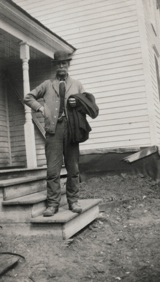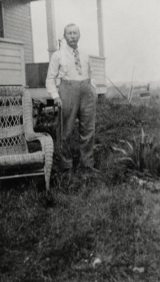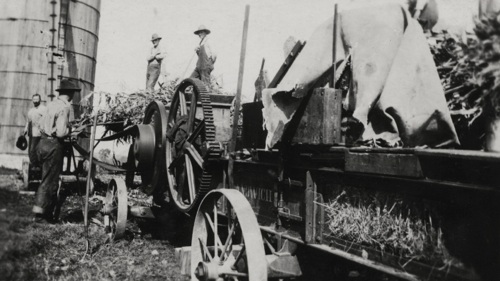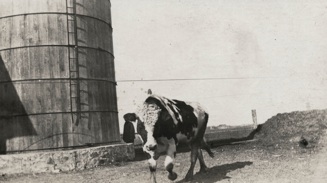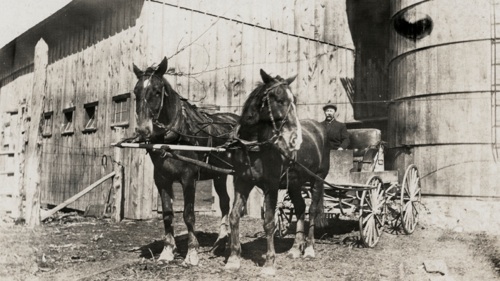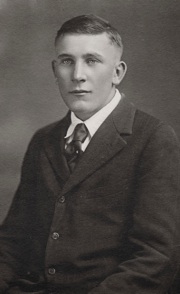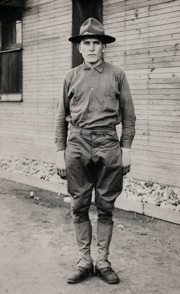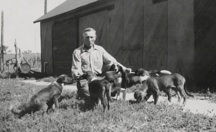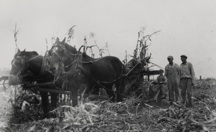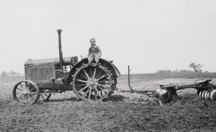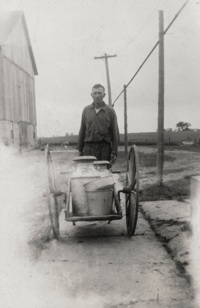From The Bley Photo Album












Jim Bley, Hard Worker and Family Man
All of these pictures of the Bley farm came from the old John Bley house. A few of the older photos were in a small box that was filled with various pictures of people long forgotten, but most of these snapshots were from an old album that had been salvaged from the house after John Patrick Bley died. Most of the photos were not identified with any markings other than an occasional name or date. The more recent pictures have been identified by family members who knew and remembered them, but we have no memories of what “the old folks” looked like when they were younger. We can only go on resemblance of distinguishing features, allowing for aging. These are two pictures that appear to be Jim Bley as a younger man than we knew him. He seems to have the same eyes, nose and ears as the Jim Bley we all knew and loved, including the brushy “cookie duster” mustache. The left photo looks like it was taken in the back of the old Bley house. He appears to be a younger man in this photo, perhaps in his thirties or so. In the right photo, he is a much older man, perhaps in his late fifties or early sixties. This snapshot was taken at George Bley’s home. George was his youngest son who lived across the road. His oldest son, John Patrick, continued to live on in the old homestead after they divided the farm. George built a new home across the road.

Preparing Silage For The Winter Months Ahead
The top photo was marked 1919 on the back. All three seem to have been taken at the same place and time and are all on post cards, a very popular style of photo at that time. It was not the Bley’s barn shown in the bottom picture however, although it appears to be Jim Bley driving the team. Sometimes when special equipment was needed to do a big job, some of the neighboring farmers would get together to accomplish the work. This appears to be one of those times. The corn stalks are being fed into a hopper to be chopped into silage as fodder for the cows. Silage added roughage to their diets as well as nutrition to supplement the hay. The belt-driven chopper is probably powered by a steam engine. Steam engines were still very popular in 1919. They were powerful and reliable and usually burned wood, a plentiful source of fuel in rural Wisconsin then. They are working right next to the silo. There was a shaft between the silo and the barn with doors at intervals down the silo side. A man would climb up the inside of the shaft on a ladder to the level of the stored silage. He’d then climb into the silo and fork the silage down to the bottom of the shaft. From there it was fed directly into the barn.
At first glance it looks like James Bley is driving a buggy in this picture, but that’s not really the case. He just enjoyed woking in comfort. His team is hitched up to a wagon that has been modified with an old, cushioned seat from a Model T Ford - much more “comfy” than a wagon seat. No doubt he used the wagon for hauling milk because a milk can is setting behind the seat. He’s probably heading home for the late milking after a long, hard day’s work.
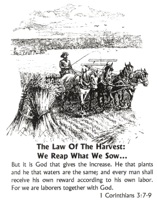

John Patrick Bley
Third-Generation Owner of The Old Bley Homestead
John P. Bley, oldest son of James W. Bley, and grandson of John Hugo Bley, inherited the part of the property that had the old house on it. Here are two pictures of John P. in his younger years. In the portrait to the right, he appears to have been in his late teens (about 1914-1915). In the picture below, he is wearing his World War I uniform which would date it to about 1918. He would have been about 21 at that time. He was a good-looking young man.


TOP LEFT: After the corn was ripened and hand picked, the stalks were cut and bound into shocks. This picture shows their horse-drawn corn binder. One of George’s sons holds the horse’s reins steady as they take this “picture break”. George and John P. are standing close by, “just in case”. The corn binder cut the corn stalks and bound them together into shocks, tying them with binder’s twine. If the stalks needed further drying, the shocks could be stood upright. If not, they just let them lay flat until they could be loaded onto a wagon and put through the silage chopper as shown in the earlier pictures.
CENTER LEFT: This picture was dated June 12, 1941. Edward J. Bley sits on the wheel housing of their old gasoline-powered tractor. This one has World War I vintage wheels: metal wheels with big iron cleats, not inflatable rubber tires. There would have been a big difference in the ride! The high exhaust pipe was tall enough to keep the denser fumes out of the driver’s face. Tractors had so much paraphernalia being pulled behind that they probably had less problems with a front vented exhaust system. The tractor is pulling a tandem disc harrow that chops and mulches the residue of the harvest field, preparing it for the new seed bed. The first row of discs would plow the dirt toward the center, and the second row leveled it back out again, breaking up the larger clots into a finer soil bed.
BOTTOM: John P. stops to pet his dog and her large litter of puppies. The old wind-powered pump is gone and the new electric pump is seen to the left in the background.
Bley Brothers, John P. And George Bley
These shots were taken during John P. and George’s generation of ownership. The basic farm work was the same as before, but some general improvements had been made in equipment and methods.

John P. is hauling milk with a nifty hand cart, probably home made with buggy wheels.




